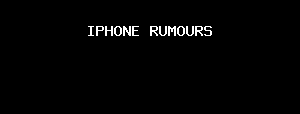profile/4904Snapchat-1431714013.jpg
Maxdking

IPHONE RUMOURS
~2.8 mins read
Mac Rumors
iPhone 12 AirPods Studio HomePod Apple Watch Series 6 iPad Air 2021 iPhones iOS 14 iPad macOS 11 Big Sur AirPods Pro iMac iPhone 11 iPhone 11 Pro iPhone SE 2020 iPhone XR Apple Pro Display XDR Mac Pro macOS Catalina Apple Glasses AirPods 2 Apple Deals Apple Watch SE iPad mini 5 iPod touch Mac mini MacBook Air Apple TV iPhone XS MacBook Pro Apple Car Apple Stores iMac Pro iPad Pro CarPlay iPadOS 14 tvOS 14 watchOS 7 Apple Black Friday Apple Pay
Magnetically Attached iPhone 12 Wireless Charger Unveiled Ahead of Apple Event
Oct 12, 2020 8:32 pm PDT by Arnold Kim
Macotakara points to a new product unveiled today by Japanese accessory manufacturer MPOW. The device is a magnetically attached wireless charger designed for the "new iPhone".
MPOW JAPAN Co., Ltd. (Location: Chuo-ku, Tokyo, Representative: Takehiko Komazaki) announces a wireless charger that supports the charging position adjustment function using a magnet, which is a new wireless charging mechanism installed in the new ‌iPhone‌.
The company goes on to describe the product having a "ring-shaped magnet mechanism" which matches up with a similar mechanism in the new ‌iPhone‌, allowing the charger to firmly attach to the device. This allows for better charging performance than traditional wireless chargers which may move position over time. The company also notes that the product "is intended for use with new iPhones, may not be able to be charged when used with other smartphones."
The product announcement comes hours before Apple's event on October 13th which is expected to unveil the iPhone 12. One of the most recent rumors suggested that Apple would revive the "MagSafe" brand but apply it to two new magnetic chargers designed for the ‌iPhone 12‌. These were dubbed "MagSafe Charger" and "MagSafe Duo Charger".
The rumor follows up other leaks that have shown the magnetic rings that have been shown in schematics and built into cases.
Related Roundup: iPhone 12
Tags: macotakara.jp, Apple event Guide, MagSafe
[ 113 comments ]
Top Rated Comments(View all)
Avatar
skiwildcat7
4 hours ago at 08:38 pm
I have a great idea: you connect a cable to the phone via a small hole in the phone and that cable is connected to the wall which delivers electricity over the cable at rates much faster than this supposed wireless charging. It’s an incredible invention let me tell you. I call it a “plugâ€.
Score: 44 Votes
Avatar
joeblow7777
4 hours ago at 08:36 pm
How is this a “wireless†charger? If this is wireless, the so was MagSafe on MacBooks.
Rating: 21 Votes
Avatar
WoodpeckerBaby
4 hours ago at 08:38 pm
I don’t see how that is wireless charging. I see a big cable and big connector right there, probably with lots of heat. How is this better than using the USB PD charging cable?
Rating: 15 Votes
Avatar
ethanwa79
4 hours ago at 08:40 pm
They can't remove the port. CarPlay needs a port, can't do it with Bluetooth.
uhhh wireless CarPlay?
Rating: 12 Votes
Avatar
slimejester
4 hours ago at 08:38 pm
I mean, who doesn’t lay their phone face down against a marble inkwell?
Rating: 9 Votes
Avatar
joeblow7777
4 hours ago at 08:40 pm
Getting ready to remove the port in iPhone 13
I doubt it. Wireless charging still isn’t ubiquitous enough. This isn’t like removing the headphone jack. If people can’t charge their phone in a convenient way it’s completely useless to them.
Rating: 8 Votes
[ Read All Comments ]
Copyright © 2000-2020 MacRumors.com, LLC.
Privacy/DMCA contact
profile/4904Snapchat-1431714013.jpg
Maxdking

ASTRONOMERS DISCOVERY
~2.7 mins read
Astronomers see a black hole 'spaghettify' a star in real time
Coming too close can mean being instantly transformed into some very unpleasant pasta.
Eric Mack headshot
Eric Mack
Oct. 12, 2020 11:10 a.m. PT
Artist's impression of star being tidally disrupted by a supermassive black hole.
ESO/M. Kornmesser
It's one of those astounding events that sounds like science fiction, but is just plain science. Astronomers say they were able to capture in unprecedented detail the process of a star being ripped into strips and devoured by a black hole.
The powerful phenomenon caught the attention of scientists when a new blast of light near a known supermassive black hole was spotted by telescopes around the world. Months worth of follow-up observations made it clear they were seeing the destruction of a far-off sun as it happened.
CNET SCIENCE
From the lab to your inbox. Get the latest science stories from CNET every week.
Add your email
SIGN ME UP!
By signing up, you agree to the CBS Terms of Use and acknowledge the data practices in our Privacy Policy. You may unsubscribe at any time.
"In this case the star was torn apart with about half of its mass feeding -- or accreting -- into a black hole of one million times the mass of the sun, and the other half was ejected outward," explained astronomer Edo Berger from the Harvard-Smithsonian Center for Astrophysics, in a statement.
The violent scene is what astronomers call a tidal disruption event, which happens when a star comes too close to a black hole and gets shredded through a process of spaghettification -- basically, the gravity of the black hole is so intense that it stretches whatever comes near vertically into long, thin shapes like pieces of spaghetti as it swallows it all up.
What is a black hole? The universe's dark, mysterious monsters
See all photos
+18 More
The event, which goes by the catalog entry AT2019qiz and is the closest such flare ever seen at just 215 million light-years away, was caught early enough that scientists have been able to get a relatively unobscured view of the cosmic carnage before a cloud of star guts pulls a veil over the region.
"We could actually see the curtain of dust and debris being drawn up as the black hole launched a powerful outflow of material with velocities up to 10,000 km/s (22 million miles per hour)," explained Kate Alexander, a NASA Einstein Fellow at Northwestern University. "This is a unique 'peek behind the curtain' that provided the first opportunity to pinpoint the origin of the obscuring material and follow in real time how it engulfs the black hole."
A paper on the discovery was published Monday in Monthly Notices of the Royal Astronomical Society.
The event is so close and clear that Berger says it will help scientists learn more about the powerful forces at work, particularly the simultaneous pull of the shredded star into the black hole and the outward explosion of material from the star.
"Until now, the nature of these emissions has been heavily debated, but here we see that the two regimes are connected through a single process."
The hope is that AT2019qiz could be a sort of Rosetta stone for studying and interpreting what black holes have for lunch in the future. One distant day, intergalactic space travelers may even give thanks that this discovery regularly allows them to warp around the universe without turning into space spaghetti.
First published on Oct. 12, 2020 at 5:15 a.m. PT.
COMMENTS
Sci-Tech Space
Advertisement

Link socials
Matches
Loading...
